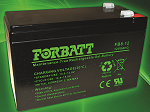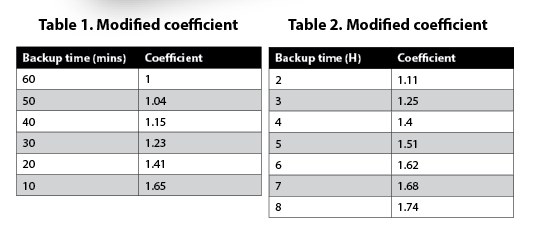UPS battery configuration made easy
28 August 2019
Power Electronics / Power Management

Determining the UPS (uninterruptible power supply) battery configuration using a formula can be quite complicated and, since many users are not very familiar with it, a more simplified method can be used to speed up the process and thereby save time.
This is typically done in the pre-planning phase before designing the practical application solution. The battery configuration can be quickly and simply calculated based on the UPS output load and the required backup time. The formula is as follows:Required battery capacity (Ah) = UPS capacity (kVA) x 109 (Ah/cell) + kVA + number of battery blocks per group
Example 1
As an example, consider a 130 V d.c. system of 120 kVA operating a UPS with 32 cells in series per bank, and requiring a backup time of 60 minutes. The required battery capacity is:
120 kVA x 109 Ah (cell/kVA) = 13 080 Ah (total requirement)
13 080 Ah / 32≈409 Ah
Therefore, if using a 12 V, 100 Ah battery bank x 4, there is a choice between using 32 cells per group, in which case the actual backup time will be less than 60 minutes, or 33 cells per group, resulting in a backup time of slightly more than 60 minutes.
If the required backup time is 30 minutes, then:
120 x 109 = 13 080 Ah
13 080 / 32≈409 Ah (for 60 minutes)
409 / 2≈205 Ah
However, since the discharge power and discharge time of the battery are not linear, simply dividing by 2 is incorrect; rather, a modified coefficient must be used (see Table 1). Therefore, in this case, 205 x 1,23≈252 Ah, so one option could be 4 banks (32 cell/bank) of 12 V, 65 Ah battery.
If the backup time requirement is 20 minutes, then:
120 x 109 = 13 080 Ah
13 080 / 32≈409 Ah (for 60 minutes)
409 / 3≈136 Ah
136 x 1,41 (modified coefficient) 192 Ah
Therefore, one option could be 3 banks (32 cells/bank) of 12 V, 65 Ah batteries.
Example 2
Consider a 126 Ah/cell/kVA system, of 120 kVA UPS with 32 cells per bank. If the required backup time is more than one hour you also need to consider the modified coefficient in the calculation (see Table 2).
If the required backup time is 3 hours, then:
126 x 120 = 15 120 Ah
15 120 / 32≈472 Ah
472 x 3 = 1 416 Ah (for 3 hours)
Then divide it by a modified coefficient as 1 416 / 1,25≈1 133 Ah
The option of 4 banks of 12 V, 300 Ah batteries can therefore be selected.
According to the principle of energy conservation, the above method is the same for three-phase/single-phase or single-phase/single-phase UPS. Generally, high-power UPS systems are equipped with 32 batteries per battery pack and the number of parallel batteries should not exceed 4 so as not to affect the current sharing and charging effect of the battery pack.
However, the above is a simplified method that is only a rough calculation where the result which is not completely accurate. To obtain a more accurate result, one will also need to consider the parameters of the equipment, the requirements of the application, the power grid condition and the power conversion efficiency.
For more information contact Forbatt SA, +27 11 469 3598, [email protected], www.forbatt.co/index.php
Further reading:
ABB’s Mission to Zero drives South Africa’s energy transition
ABB Electrification Products
Power Electronics / Power Management
ABB Electrification is charting a bold path towards a net-zero future with its Mission to Zero programme, a blueprint that combines energy efficiency, electrification, and digital innovation to accelerate the transition to clean energy.
Read more...
Energy harvesting using a battery-less IoT system
NuVision Electronics
Editor's Choice Power Electronics / Power Management
Energy Harvesting plays an essential role in the foundation of ambient IoT, a new generation of ultra-low power connected devices that operate by drawing energy from their environment instead of relying on traditional batteries.
Read more...
Driving power, defining performance
Future Electronics
Power Electronics / Power Management
Vishay’s portfolio of inductors, current sense resistors, and MOSFETs provides a comprehensive solution for intelligent power management.
Read more...
Battery simulator module simplifies BMS testing
Test Dynamics
Power Electronics / Power Management
The PXI/PXIe solution from Pickering Interfaces offers a scalable, modular design for faster development cycles, lower total cost of ownership, and improved safety.
Read more...
DC PSU: The cornerstone for efficient solar-storage systems
Vepac Electronics
Power Electronics / Power Management
PV energy storage systems are evolving and DC power supplies, with their technical characteristics that are naturally compatible with new energy, have become a key carrier for improving system energy efficiency.
Read more...
Why local manufacturing, maintenance and support are key to the success of South Africa’s energy future
Power Electronics / Power Management
Although new renewable generation capacity is being developed, the current transmission infrastructure may not fully support the connection of these sources to the national grid or adequately deliver power to areas of high demand.
Read more...
Converter power modules for 48 V networks
Altron Arrow
Power Electronics / Power Management
The economic and quality-of-life benefits of electrification is driving the adoption of HV to 48 V DC-DC conversion across many markets with 48 V power modules becoming more common.
Read more...
The importance of power integrity
Spectrum Concepts
Power Electronics / Power Management
[Sponsored] Behind every high-speed system lies the need for power integrity. Without it, even the cleanest signal paths become compromised.
Read more...
Precise multi-vital sign monitoring
Future Electronics
Power Electronics / Power Management
The AS7058 by ams OSRAM is an integrated multi-vital sign monitoring device, which provides a complete photoplethysmogram, electrocardiogram, body impedance sensor, and electrodermal activity sensor.
Read more...
Automotive battery diagnostics tester
Comtest
Power Electronics / Power Management
Midtronics’ MVT handheld battery tester is a revolutionary tool, powered by MDX-AI, which is set to redefine the standards of battery diagnostics and testing in the automotive industry.
Read more...



